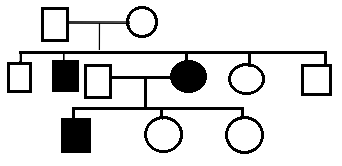The trait shown in the given pedigree chart is most likely a/an:

1. Autosomal recessive trait
2. Autosomal dominant trait
3. Sex linked recessive trait
4. Sex linked dominant trait
In the following human pedigree, the filled symbols represent the affected individuals. Identify the type of given pedigree
1. Autosomal dominant
2. X-linked recessive
3. Autosomal recessive
4. X-linked dominant
Study the pedigree chart given below

What does it show?
| 1. | Inheritance of a sex-linked inborn error of metabolism like phenylketonuria |
| 2. | Inheritance of a condition like phenylketonuria as an autosomal recessive trait |
| 3. | The pedigree chart is wrong as this is not possible |
| 4. | Inheritance of a recessive sex-linked disease like haemophilia |
Study the pedigree chart of a family showing the inheritance of myotonic dystrophy.
The trait under study is
1. dominant X-linked
2. recessive X-linked
3. autosomal dominant
4. recessive Y-linked.
Given below is a pedigree chart of a family with five children. It shows the inheritance of attached ear-lobes as opposed to the free ones. The squares represent the male individuals and circles the females individuals. Which one of the foloowing conclusions drawn is correct?
(1) The parents are homozygous recessive.
(2) The trait is Y-linked.
(3) The parents are homozygous dominant.
(4) The parents are heterozygous.
Given below is a pedigree chart showing the inheritance of a certain sex-liniked trait in humans.
The Trait traced in the above pedigree chart is
(1) dominant X-linked
(2) recessive X-linked
(3) dominant Y-linked
(4) recessive Y-linked
Which of the following is true for a recessive disease in family A and B?
(1) In family A, both the parents are homozygous recessive.
(2) In family B, both the parents are homozygous dominant.
(3) In family B, both the parents are heterozygous recessive.
(4) In family A, both the parents are heterozygous recessive.
In the given pedigree chart select the correct statement:
(1) A & B are twins
(2) A is younger than B
(3) B is younger than A
(4) Can’t determine the age of A & B
If two people who are carrier for a genetically inherited fatal recessive disease decide to marry and disease cause still birth. What is the probability of the live children to be a carrier?
a.1/2
b.2/3
c.1/4
d.1/3
The family pedigree of Queen Victoria shows a number of haemophilic descendants as she was:
1. Affected by the disease
2. Carrier for the disease
3. Did not carry the allele for hemopihilia
4. Was not a queen












